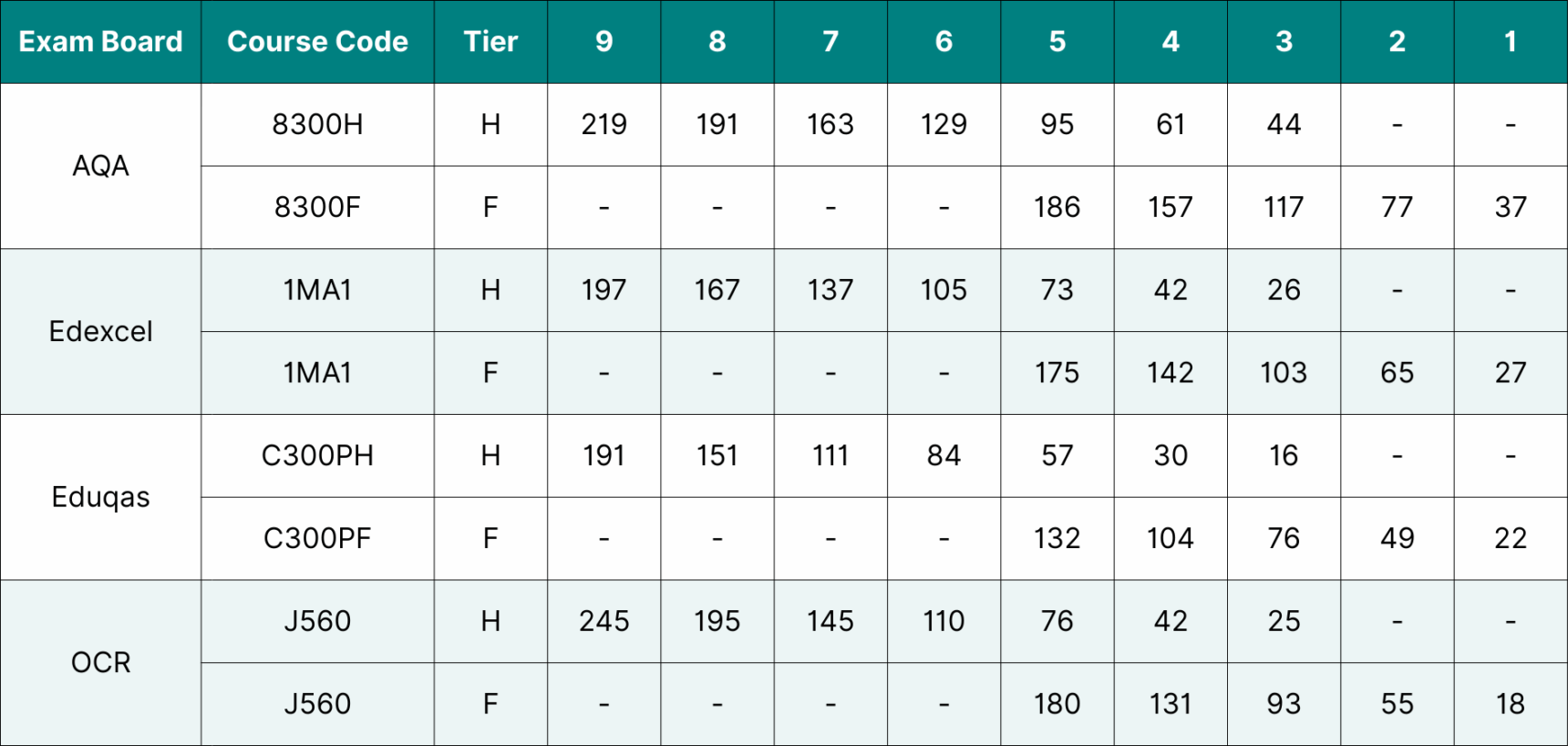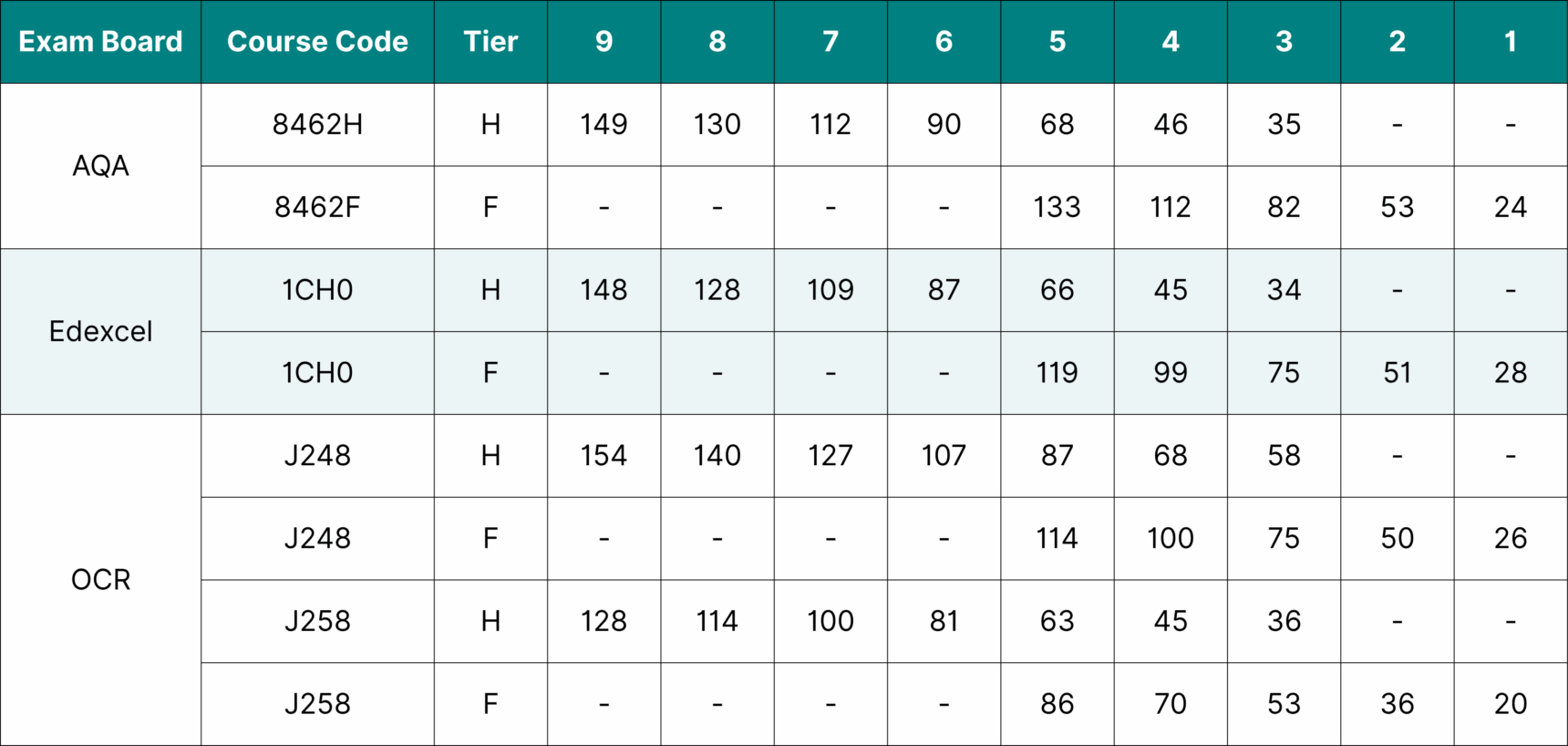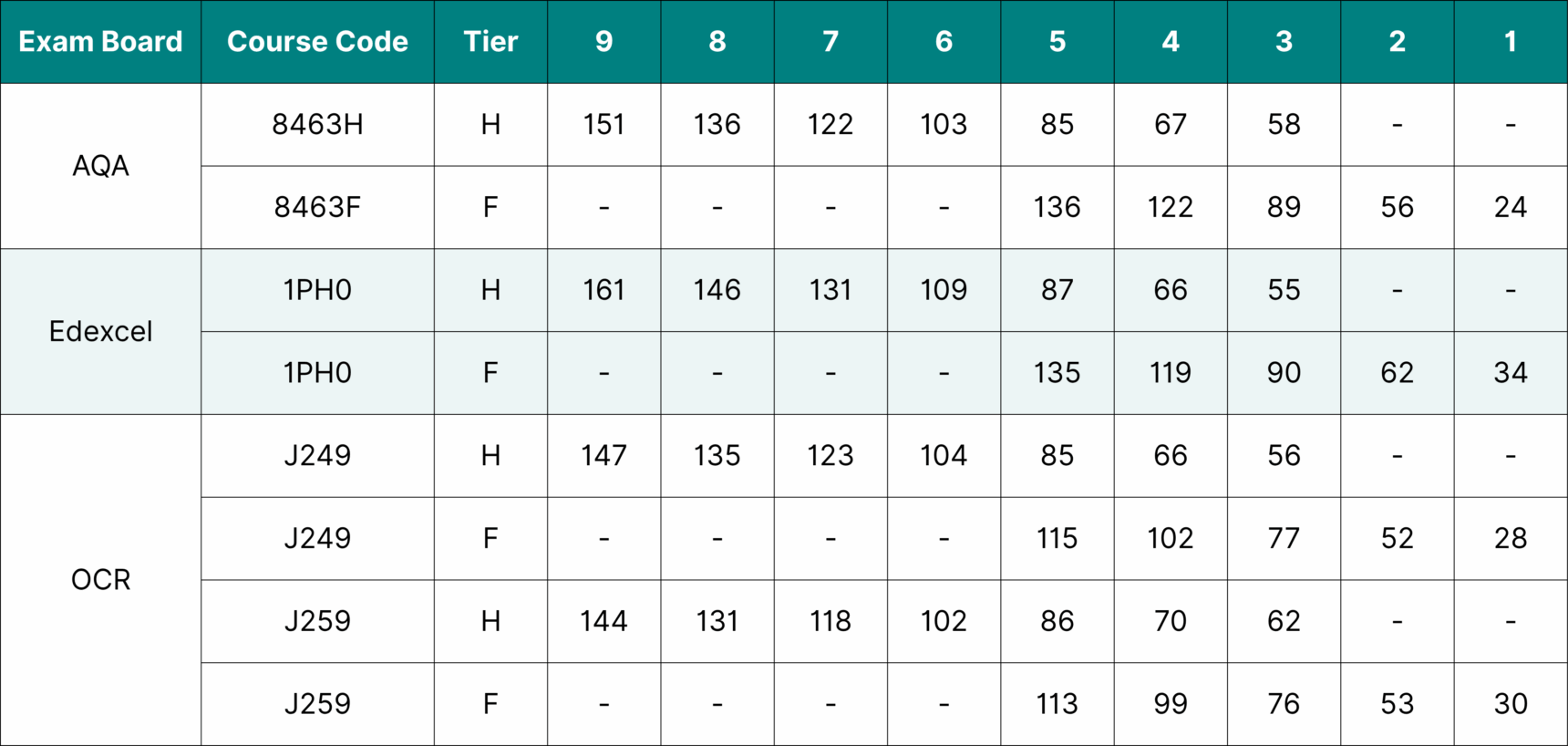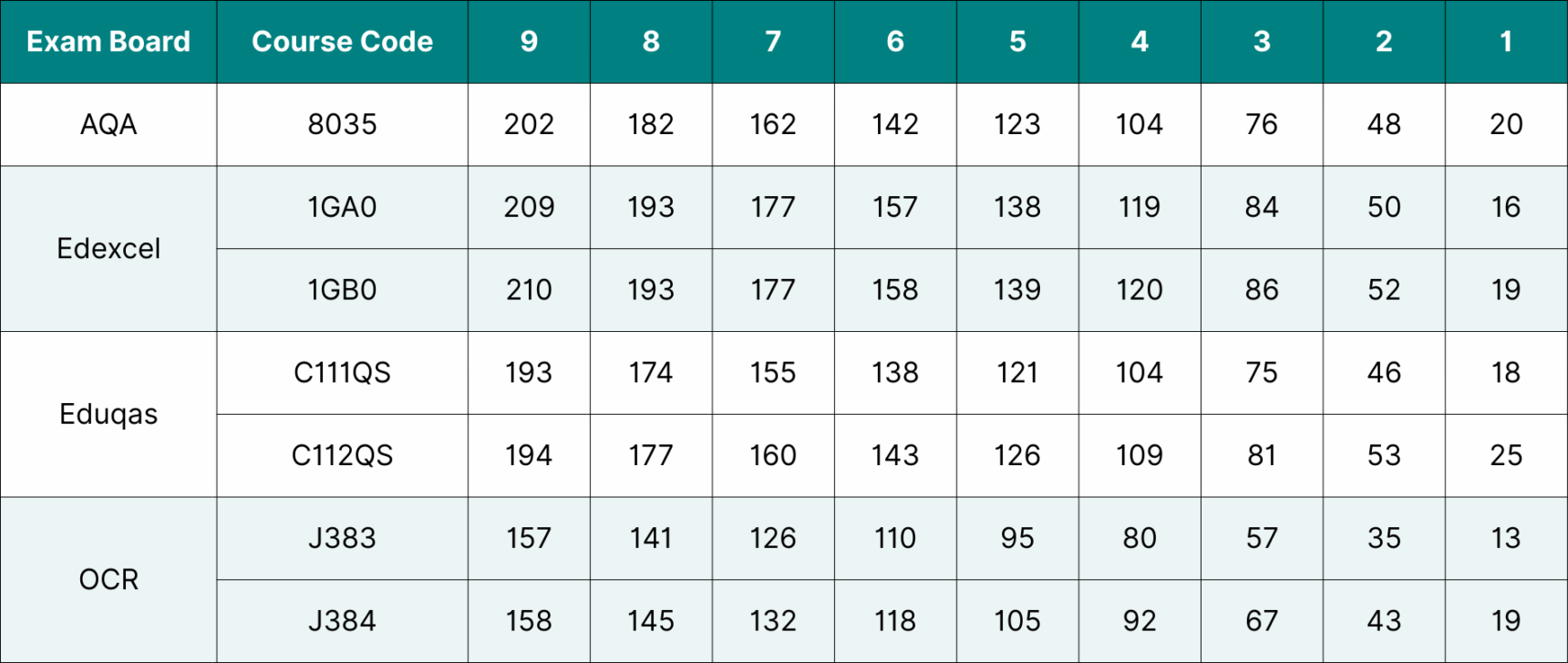Contents:
Understanding how GCSEs are graded can feel confusing, especially when terms like “grade boundaries” start appearing around Results Day. In this guide to GCSE grade boundaries 2025, we’ll explain what grade boundaries are, how they’re set, and why they matter. We’ll also share the 2025 grade boundaries, alongside data from previous years, to help you make sense of your child’s results.
What are GCSE grade boundaries?
GCSE grade boundaries are the minimum number of marks students need to achieve a specific grade in an exam. They convert raw exam scores into final GCSE grades, which follow the 9–1 grading scale in England (with 9 being the highest).
These boundaries can vary slightly from one exam series to the next, depending on the difficulty of the paper. For example, if a paper is considered more challenging than usual, the boundary for a grade 4 (a standard pass) may be set lower than in a previous year.
Understanding grade boundaries provides context to your child’s results, helping to explain how a certain number of marks led to a particular grade. This is especially useful if you are thinking about requesting an exam remark, as it shows how close your child was to the next grade up. If your child was only one or two marks away from the next grade, a review of marking could be worthwhile.

How are GCSE grade boundaries set?
Exam boards set grade boundaries after all the papers have been marked. They use a process called awarding, where senior examiners review overall performance across the entire student cohort and consider how this year’s papers compare to previous years.
Grade boundaries are adjusted to reflect the difficulty of each paper, ensuring that students aren’t unfairly penalised—or advantaged—by an exam that was harder or easier than expected.
This process helps maintain consistency from year to year, so that, for example, a grade 7 in 2025 represents the same standard of achievement as a grade 7 in previous years.
When do GCSE grade boundaries come out?
GCSE grade boundaries are usually published by exam boards on the morning of Results Day, just before students receive their grades. In 2025, GCSE Results Day takes place on Thursday 21st August.
The grade boundaries are released for each subject, allowing schools, students, and parents to see how many marks are needed to achieve each grade.
GCSE grade boundaries 2025
The tables below show the GCSE grade boundaries for 2025 in key subjects, including maths, English, science, and geography—across the main exam boards: AQA, Edexcel, Eduqas, and OCR. They detail the number of raw marks needed to secure each grade in the June 2025 exam series.
For other subjects, please check the official exam board publications:
- AQA GCSE grade boundaries 2025
- Edexcel GCSE grade boundaries 2025
- Eduqas GCSE grade boundaries 2025
- OCR GCSE grade boundaries 2025
A note on notional grade boundaries
Notional grade boundaries indicate the approximate mark thresholds for individual exam papers. They’re designed to give an idea of how a student’s performance on each paper contributes to their overall grade for the subject.
These notional boundaries are provided by exam boards for illustrative purposes only—they are not official grades. However, they can be useful for understanding how your child performed on different parts of an exam, especially if they excelled in one paper but struggled in another. They can also help teachers and schools identify areas where students may need extra support in the future.
The tables below show the overall grade boundaries for each subject. Notional grade boundaries are not included, but you can view them by visiting the relevant exam board websites.
GCSE Maths grade boundaries 2025
AQA GCSE Maths grade boundaries 2025

*Maximum marks: 240
Edexcel GCSE Maths grade boundaries 2025

*Maximum marks: 240
Eduqas GCSE Maths grade boundaries 2025

*Maximum marks: 240
OCR GCSE Maths grade boundaries 2025

*Maximum marks: 300

GCSE English Language grade boundaries 2025
AQA GCSE English Language grade boundaries 2025

*Maximum marks: 160
Edexcel GCSE English Language grade boundaries 2025

*Maximum marks: 160
Eduqas GCSE English Language grade boundaries 2025

*Maximum marks: 200
OCR GCSE English Language grade boundaries 2025

*Maximum marks: 160
GCSE English Literature grade boundaries 2025
AQA GCSE English Literature grade boundaries 2025

*Maximum marks: 160
Edexcel GCSE English Literature grade boundaries 2025

*Maximum marks: 160
Eduqas GCSE English Literature grade boundaries 2025

*Maximum marks: 200
OCR GCSE English Literature grade boundaries 2025

*Maximum marks: 160

GCSE Biology grade boundaries 2025
AQA GCSE Biology grade boundaries 2025

*Maximum marks: 200
Edexcel GCSE Biology grade boundaries 2025

*Maximum marks: 200
OCR GCSE Biology grade boundaries 2025

*Maximum marks: 180
GCSE Chemistry grade boundaries 2025
AQA GCSE Chemistry grade boundaries 2025

*Maximum marks: 200
Edexcel GCSE Chemistry grade boundaries 2025

*Maximum marks: 200
OCR GCSE Chemistry grade boundaries 2025

*Maximum marks: 180

GCSE Physics grade boundaries 2025
AQA GCSE Physics grade boundaries 2025

*Maximum marks: 200
Edexcel GCSE Physics grade boundaries 2025

*Maximum marks: 200
OCR GCSE Physics grade boundaries 2025

*Maximum marks: 180

Need support with GCSEs? We can help.
From tricky topics to fine-tuning exam technique, our carefully selected tutors provide personalised support to help your child gain confidence and achieve their best results. Use code BLOG15 for £15 off your first tutoring session.
Find a tutorGCSE Combined Science grade boundaries 2025
Due to how combined science grades are calculated, there are 17 possible grade combinations. To see the grade boundaries for each combination, please refer to the exam board documents linked below:
GCSE Geography grade boundaries 2025
AQA GCSE Geography grade boundaries 2025

*Maximum marks: 252
Edexcel GCSE Geography grade boundaries 2025

*Maximum marks: 256
Eduqas GCSE Geography grade boundaries 2025

*Maximum marks: 252
OCR GCSE Geography grade boundaries 2025

*Maximum marks: 200

What were the GCSE grade boundaries for 2024?
Reviewing the GCSE grade boundaries from 2024 can offer valuable insight into how many marks were needed to achieve each grade last year, and what to potentially expect in 2025. While grade boundaries can vary slightly each year depending on the difficulty of the papers, past data is a useful tool for spotting trends and setting realistic expectations.
Below, you’ll find the 2024 grade boundaries for key subjects—maths, English, science, and geography. This data is from the June 2024 exam series and shows the total raw marks required to achieve each grade.
For subjects not included in the tables below, please refer to the following exam board documents:
- AQA GCSE grade boundaries 2024
- Edexcel GCSE grade boundaries 2024
- Eduquas GCSE grade boundaries 2024
- OCR GCSE grade boundaries 2024
GCSE Maths grade boundaries 2024

Note: OCR’s raw marks are out of 300; other boards are out of 240.
GCSE English Language grade boundaries 2024

Note: Eduqas’s raw marks are out of 200; other boards are out of 160.
GCSE English Literature grade boundaries 2024

Note: Eduqas’s raw marks are out of 200; other boards are out of 160.
GCSE Biology grade boundaries 2024

Note: OCR’s raw marks are out of 180; other boards are out of 200.
GCSE Chemistry grade boundaries 2024

Note: OCR’s raw marks are out of 180; other boards are out of 200.
GCSE Physics grade boundaries 2024

Note: OCR’s raw marks are out of 180; other boards are out of 200.
GCSE Combined Science grade boundaries 2024
Due to how combined science grades are calculated, there are 17 possible grade combinations. To see the grade boundaries for each combination, please refer to the exam board documents linked below:
GCSE Geography grade boundaries 2024

Note: Edexcel’s raw marks are out of 256, AQA and Eduqas are out of 252, and OCR is out of 200.

GCSE grade boundaries for 2019-2023
The COVID-19 pandemic had a significant impact on GCSE assessments between 2020 and 2022. In 2020 and 2021, traditional exams were cancelled, and students were awarded grades based on teacher assessments. As a result, no official exam grade boundaries were set for those years.
In 2022, formal exams resumed, but with adaptations to support students whose learning had been disrupted—such as advance information on exam topics, supporting materials, and optional content in some subjects. Grade boundaries in 2022 were generally more lenient than in pre-pandemic years to reflect these challenges.
By 2023, the government aimed to return to pre-pandemic grading standards. This means grade boundaries began to tighten again to align more closely with the levels of difficulty and marking seen before 2020. This return to “normal” has continued into 2024 and is expected to remain consistent in 2025.
AQA GCSE grade boundaries 2019-2023
Edexcel GCSE grade boundaries 2019-2023
Eduqas GCSE grade boundaries 2019-2023
OCR GCSE grade boundaries 2019-2023
Understanding GCSE grade boundaries can provide valuable insight into how your child’s raw marks translate into final grades. While grade boundaries may vary slightly from year to year to reflect exam difficulty, they help put your child’s results into context and can guide important decisions—whether that’s about exam remarks, resits, or planning next steps in their education.

Book Our Christmas Mock Preparation Courses!
Is your child in Year 11? Taught by expert tutors, our online Christmas Mock Preparation Courses focus on targeted revision and exam technique to help GCSE students feel confident for their January mocks. Enjoy 10% off with code BLOGCOURSES10.
Book now







Comments